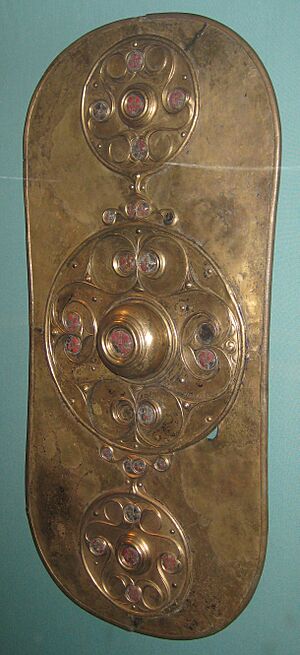Celtic shields facts for kids
Celtic shields were important tools used by the Celts and other ancient groups in battles. These shields were their main way to protect themselves. You can often find them in ancient burial sites from the Iron Age, especially where men were buried. Two very famous Celtic shields are the Witham shield and the Battersea shield.
What Did Celtic Shields Look Like?
Celtic shields usually had an oval or long oval shape. Some were also round or even hexagon-shaped. In the middle of the front, there was often a hollow wooden part called a "boss." This boss was there to protect the warrior's hand. It was often made longer to make the shield stronger. Sometimes, a metal plate covered the boss.
Inside the boss, there was a handle for holding the shield. These shields were made from wood, often oak or linden wood. Most of the time, they were also covered with leather for extra strength and protection.
Shields for Battle
Shields used in battles were often decorated in special ways. Each shield might have unique symbols on it. They were made to be both light enough to carry and strong enough to stop attacks.
Celtic warriors used their shields not just for defense, but also as a way to attack! A common trick was to hit an enemy with the shield. Celts living in Great Britain used smaller shields in fights. However, Celts on the European continent often used larger shields. Shields could break during combat, so they were seen as items that could be replaced.
Shields for Ceremonies
Some Celtic shields have been found in rivers, like the River Thames near Battersea and the River Witham in Lincolnshire. These shields were covered with thin metal sheets. They had beautiful Celtic designs pressed into them.
These shields were larger than battle shields, but still made of wood. It's clear that these special shields were used for important ceremonies or parades, not for fighting. They were too fancy and delicate for the rough use of battle.



